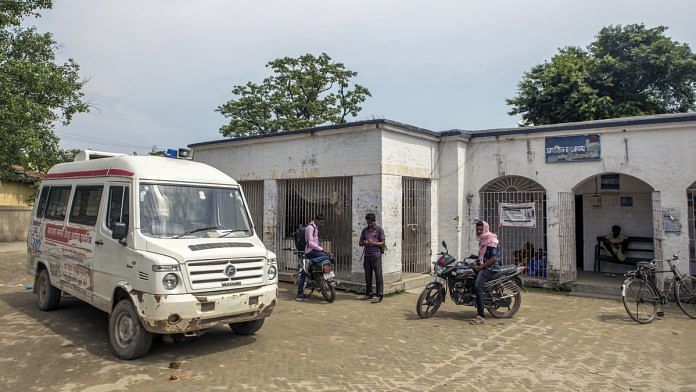CPR report says healthcare centres don’t meet standards designed by health ministry in terms of infrastructure, manpower, medical equipment and drugs.
New Delhi: Not a single rural healthcare centre in 15 Indian states meets the bare minimum quality standards — set by the Ministry of Health and Family Welfare — such as establishing essential infrastructure, employing the minimum mandated manpower apart from buying required medical equipment and drugs.
The findings are part of a report by the Centre for Policy Research (CPR), a New Delhi-based think-tank, which collated government data to find that much of the three-tier healthcare system — of sub-centres (SCs), primary health centres (PHCs) and the community health centres (CHCs) — does not conform to the Indian Public Health Standards (IPHS) set by the ministry.
CPR found that as on March 2018, of the 1.58 lakh SCs, only 11,000 centres (a mere 6 per cent) met IPHS norms. Similarly, of the 25,700 PHCs, only 3,000 (12 per cent) adhered to the norms while in case of CHCs, only 728 of the 5,600 follow basic standards.
“Out of the total 36 states (29 states and seven union territories), 15 states have reported zero centres functioning as per IPHS norms,” the CPR report says.
The list includes Telangana, Arunachal Pradesh, Assam, Chhattisgarh, Himachal Pradesh, Jharkhand, Karnataka, Manipur, Meghalaya, Mizoram, Odisha, Punjab, Rajasthan, Tripura and West Bengal.
The IPHS is a set of measures designed to improve the quality of health infrastructure in all centres, including government hospitals. These norms are expected to be the primary benchmarks for assessing the improvement of quality and functioning status of health facilities.
While health ministry officials refused to come on record on the report, a senior ministry bureaucrat, requesting anonymity, said the state governments are responsible for adherence to norms.
“We are working on improving the centres but state governments are responsible for the adherence,” the bureaucrat said. “It is our mandate to improve the compliance and make these centres ready for Ayushman Bharat.”
Also read: Months after Modicare launch, 74% of specialist doctor posts found vacant in rural India
What the data says
Under the central government’s National Rural Health Mission (NRHM), healthcare in Indian villages is divided into a three-tiered structure of SCs, PHCs and CHCs.
While the SCs have nurses and midwives, the PHCs have general doctors for primary care. The CHCs are at the apex of this structure. They are 30-bed hospitals that are meant to offer specialist consultation and act as referral centres for district hospitals. They are established and maintained by the state governments.
The CHCs are to provide modern healthcare services such as X-ray machines, pathological laboratories, operation theatres and labour rooms. They are meant to not only cater to the rural population but also ease overcrowding in district hospitals.
The CPR data, however, shows a steady decline in the number of these healthcare facilities conforming to the IPHS norms.
In 2016, of the total SCs, 14 per cent met IPHS norms but by 2018, only 6 per cent complied with the norms.
For PHCs, 21 per cent met the health ministry norms in 2016 but that number reduced to 12 per cent in 2018. In the case of CHCs, 27 per cent of IPHS-compliant centres in 2016 were reduced to 13 per cent in 2018.
CPR has collated data from various government reports including the Rural Health Statistics, National Health Mission Reports, Indian Health Statistics, from the Central Bureau of Health Intelligence and the National Health Profile.
Also read: Modi’s Ayushman Bharat and price control will bring down quality of healthcare in India
‘States not spending enough to address situation’
Experts at CPR said that states weren’t spending enough to address the situation. “Despite this overburdening and decline in quality, expenditure on infrastructure out of the total available infrastructure budget has been low,” said Avani Kapur, a fellow at the Centre for Policy Research.
“During 2017-18, only 48 per cent of the total available budget for infrastructure was spent across all states,” said Kapur.
“For instance, while Odisha, Jharkhand, and Telangana were among the states to have reported zero health centres functioning as per IPHS norms over the last three years, expenditure on infrastructure as a proportion of their total available infrastructure budget, remained low at 33, 25 and 8 per cent, respectively,” Kapur added.
“Expenditure was also low in Bihar (3 per cent), Gujarat (3 per cent), and Nagaland (1 per cent).”
Amid this, the Modi government has announced the creation of 1,50,000 health and wellness centres (HWCs) for rural remote areas as part of the Ayushman Bharat by 31 December 2022.
The scheme relies heavily on the existing centres as infrastructure for HWCs is to be created, largely by transforming existing SCs and PHCs operating through national health mission.
While the government has set a target of operationalising 15,000 HWCs by 31 March 2019, less than one third, around 4,500 centres had been operationalised, till 15 December 2018.





India is spending barely 1% of its GDP on public healthcare. That is showing up in the photograph in this column. Viewed against this backdrop, promising 500 million Indians access to high quality private healthcare, including surgical procedures, costing upto half a million a year per family, lies in the distant future.